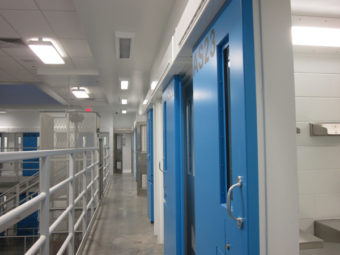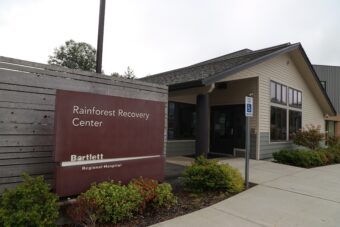
After a motorcycle accident in his teenage years, Adam Mahoney started using pills. When those pills became harder to find, he started doing heroin.
Last year, Mahoney was arrested and sent to Wildwood Pretrial Facility in Kenai.
“I knew that when I went to jail that I was going to be sick,” Mahoney said.
At the time, Mahoney was in a drug treatment program. Anticipating he wouldn’t be able to continue treatment, he tried to smuggle in Suboxone — a drug used to treat withdrawal symptoms — but the package burst in his stomach. Mahoney said he almost died.
It’s not just Mahoney who has tried to smuggle substance use treatment drugs into state facilities, where rates of substance abuse are disproportionately high.
In recent months, at least two Alaska Department of Corrections staff members have faced charges for bringing medication into correctional facilities on the Kenai Peninsula. In April, a correctional officer was charged for bringing buprenorphine into Spring Creek Correctional Facility in Seward. Earlier this month, a former staff member was charged for distributing Suboxone at Wildwood Pretrial Facility in Kenai.
Ninilchik-based addiction medicine specialist Sarah Spencer said with gaps in available treatment options, incarcerated people will go to great lengths to avoid withdrawal.
“It’s just incredibly painful in every way you can imagine,” Spencer said. “And so of course there’s going to be an enormous black market.”
‘The extremes that we’ll go to’
Spencer said today, the drug buprenorphine is the gold standard for opioid use treatment.
“There are very few medications that we have in modern medicine that are as effective as this medication is to treat this disorder,” Spencer said. “It is just incredibly effective.’
Buprenorphine is a prescription opioid that treats withdrawal symptoms and reduces cravings. (Suboxone is a brand-name version of buprenorphine and naloxone, a medicine that reverses opioid overdose.) Spencer’s Ninilchik clinic offers injections of the drug for patients in recovery.
But Spencer said people in Alaska correctional facilities often cannot access buprenorphine or other drugs through in-house treatment programs.
Drug treatment policies vary from facility to facility in Alaska. As it stands, the Department of Corrections said it will bridge patients’ medications for up to 30 days. That means inmates with methadone and Suboxone prescriptions, for example, should be able to keep on their treatment plans for up to a month after entering the system.
But that policy doesn’t account for the remainder of a person’s sentence. And Spencer said bridging doesn’t always happen, either, even though the Americans with Disabilities Act requires jails to continue incoming inmates on their medication when they enter the system, according to new guidelines from 2022.
Some state facilities do offer injections of Vivitrol — an opioid antagonist that keeps cravings away. But unlike its counterparts, Vivitrol is not an opioid and does not block withdrawal symptoms. Spencer said symptoms of withdrawal can be brutal, including severe nausea and restlessness, and that going cold turkey can be really painful. She said it’s the worst flu you’ve ever had, times 10.
Mahoney said that’s why he tried to bring Suboxone into Wildwood last year, and could be why some staff members have been caught doing the same.
“It just kind of goes to show the extremes that we’ll go to just to maintain adherence,” he said.
Megan Edge with the ACLU Alaska Prison Project said DOC often blames families and visitors when drugs are brought into facilities. After the June 2022 case at Wildwood, she said the facility was placed on lockdown — a year before the staff member was charged in the case.
‘We know what works’
Since Mahoney was released from prison, he’s gotten back on a treatment plan with Spencer’s clinic, in Ninilchik. He said he feels fortunate to have the clinic’s support.
But Spencer said the inconsistent treatments system-wide could be a lawsuit waiting to happen. She’s working with the Department of Corrections to work on getting a more consistent system in place.
DOC Spokesperson Betsy Holley said the department is in the process of expanding the treatment services it offers. She said the department could expand treatment beyond 30 days for inmates with existing prescriptions, for example, and the department could start patients on treatment while they’re incarcerated — which they don’t already do.
When asked for a timeline, she said the changes were still in their “initial stages,” and that DOC had no more information to share.
Around the U.S., stigma and bureaucracy have kept states from implementing treatment programs in jails and prison. But some states have. Rhode Island has been offering medication for addiction treatment programs in prisons and jails since 2016. Those programs start while people are incarcerated and can continue after release, when people are at a high risk of relapse and overdose.
Spencer said the data shows it’s working.
“We know what works. We know exactly what works,” Spencer said. “We just need to do it.”
She said in a crisis, there’s no time to waste.


